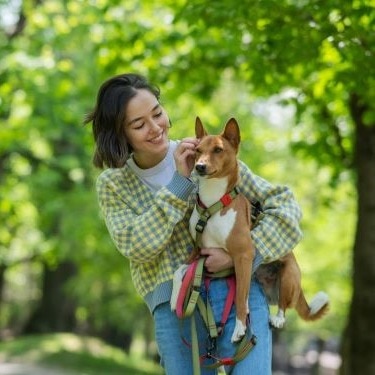
-
Find the right food for your petTake this quiz to see which food may be the best for your furry friend.Find the right food for your petTake this quiz to see which food may be the best for your furry friend.Featured products
 Adult Large Breed Chicken & Barley Recipe Dog Food
Adult Large Breed Chicken & Barley Recipe Dog FoodSupports healthy joints, lean muscle, and beautiful coat for large breed dogs
Shop Now Hill's Science Diet Adult Chicken & Beef Entrée Dog Food
Hill's Science Diet Adult Chicken & Beef Entrée Dog FoodChicken & Beef Entrée in a delicious loaf with complete & balanced nutrition to help keep adult dogs active and healthy
Shop Now Adult Chicken & Barley Recipe Dog Food
Adult Chicken & Barley Recipe Dog FoodSupports lean muscle and beautiful coat for adult dogs
Shop NowFeatured products Adult Turkey & Liver Entrée Cat Food
Adult Turkey & Liver Entrée Cat FoodPrecisely balanced nutrition with the delicious taste of minced turkey & liver to help fuel the energy needs of cats during the prime of their life
Shop Now Senior Vitality Adult 7+ Tuna & Vegetables Stew
Senior Vitality Adult 7+ Tuna & Vegetables StewImproves Everyday Ability to Get Up & Go
Shop Now Adult 7+ Indoor Chicken Recipe Cat Food
Adult 7+ Indoor Chicken Recipe Cat FoodSupports energy level and beautiful fur in mature indoor cats
Shop Now -
Dog
- Dog Tips & Articles
-
Health Category
- Weight
- Food & Environmental Sensitivities
- Urinary
- Digestive
- Joint
- Kidney
-
Life Stage
- Puppy Nutrition
- Adult Nutrition
- Senior Nutrition
Cat- Cat Tips & Articles
-
Health Category
- Weight
- Skin & Food Sensitivities
- Urinary
- Digestive
- Kidney
-
Life Stage
- Kitten Nutrition
- Adult Nutrition
Featured articles The Science Behind Our Love for Pets
The Science Behind Our Love for PetsLearn the scientific reasons why we have such strong connections with our pets, and what science says about the love between humans and our furry friends.
Read More What Is Littermate Syndrome? Pet Adoption Guide
What Is Littermate Syndrome? Pet Adoption GuideLearn more about littermate syndrome in dogs and cats and how to successfully navigate adoption and early socialization processes.
Read More How to Properly Mix Wet & Dry Pet Foods
How to Properly Mix Wet & Dry Pet FoodsAn Orange cat eating from a bowl filled with mixed food
Read More -


Whether you're going on an extended road trip or for a short drive, car travel with a dog can be a lot of fun. However, traveling with dogs in a car can pose a lot of safety risks. Read on for tips on how to safely transport your dog and minimize the dangers inherent when riding in the car with them.
Crates Are Best
When traveling with dogs in a car, the American Society for the Prevention of Cruelty to Animals recommends securing dogs of all sizes in travel-rated crates or carriers, both for the dog's safety and to prevent distractions while driving. If possible, crates should be secured in the back seat of a car or the cargo area of an SUV, station wagon, or minivan, and strapped in so that the crate won't slide around during sudden stops. The crate itself should be large enough for your dog to stand up, turn around, sit and lie down comfortably, while not so large that the dog can get tossed around inside the crate while the car moves. It should also provide plenty of ventilation. You can make the crate more comfortable for your dog by lining the floor with blankets, and even go a step further to safeguard against injury by padding the sides with foam. Just be sure your dog won't try to eat or chew any material you use for padding.
When a Crate Won't Work
If a crate is not an option, look for a safety harness that buckles directly into the seat belt buckle, and strap your dog into the back seat. Another commercially available option for safer car travel with dogs is a mesh or metal barrier made to place in minivans, and SUVs to keep your furry friend confined to the back seat. While these options are great for keeping your pup from distracting you or getting underfoot while you're trying to focus on the road, they're not designed to protect them from injury during a crash. Although it might seem like these options provide your buddy with more freedom and make the ride more enjoyable, for their own safety, a crate or carrier is still best.


Tasty Tips
When There Is No Back Seat
While the back of the car is generally safest for your dog, due mainly to potential injury from front-seat airbags, sometimes there isn't a back seat or cargo hold, as is the case with regular truck cabs or two-seater cars. In this case, it's best to secure your dog in a crate or carrier in the passenger seat and turn off the passenger-side airbags. If your dog is too large for a crate to fit in the front seat, use a safety harness to buckle them in. Under no circumstances should they be allowed to ride in the back of an open pickup truck.
On an extended road trip, it can be tempting to drive as far as you can as fast as you can (while still obeying the speed limits of course), but don't forget about your four-legged passenger in your haste to get where you're going. Plan to stop every two hours or so to give your pup a break, let them stretch their legs and do their business. It's also a good idea to bring fresh water and give your dog a drink whenever you stop. If they are not prone to getting car sick, this is also a good time to feed them a small meal.
Traveling in Comfort
Remember that these guidelines for traveling with dogs in a car are for your dog's safety as much as that of yourself and your other passengers. As such, dogs of any size should be safely restrained. Your tiny dog might be perfectly content to curl up in your lap during the trip, but just as it wouldn't be safe to hold a child in your lap while driving, it's not any safer for your dog. Securing your pup in a crate or restraining device during your trip, regardless of breed or size, will make it much more likely that you two will reach your destination safely.


Jessica Seid is an emergency veterinarian practicing in the New England area. She is a graduate of the North Carolina State College of Veterinary Medicine and has been in the field for more than a decade. When she's not helping patients, she enjoys spending time with her husband, daughter and French bulldog.
Related products

Supports lean muscle and beautiful coat for adult dogs

Supports healthy joints, lean muscle, and beautiful coat for large breed dogs

Chicken & Barley Entrée in a delicious loaf with great taste and precisely balanced nutrition to support 5 essential building blocks for lifelong health

Chicken & Beef Entrée in a delicious loaf with complete & balanced nutrition to help keep adult dogs active and healthy
Related articles

Your dog's coat and skin are a big part of your dog's overall health. Ensure you keep your dog's coat healthy, by following these simple tips.

Discover how the field of dog science is giving us more and more insights into the inner workings of our furry best friends.

Learn how to help keep your dog's immune system in tip-top shape, including nutritional immune system support for dogs and other strategies.

Wondering where can I buy a dog? Consider adoption and explore the pros and cons of adopting a dog from a breeder versus an animal shelter.

Put your dog on a diet without them knowing
Our low calorie formula helps you control your dog's weight. It's packed with high-quality protein for building lean muscles, and made with purposeful ingredients for a flavorful, nutritious meal. Clinically proven antioxidants, Vitamin C+E, help promote a healthy immune system.
Put your dog on a diet without them knowing
Our low calorie formula helps you control your dog's weight. It's packed with high-quality protein for building lean muscles, and made with purposeful ingredients for a flavorful, nutritious meal. Clinically proven antioxidants, Vitamin C+E, help promote a healthy immune system.

